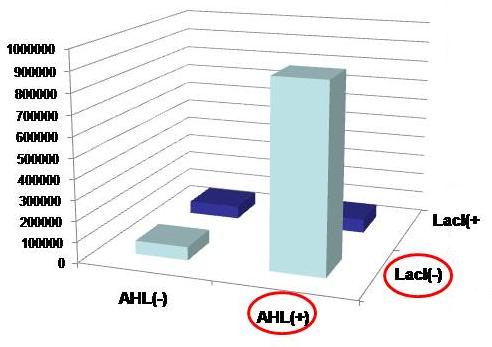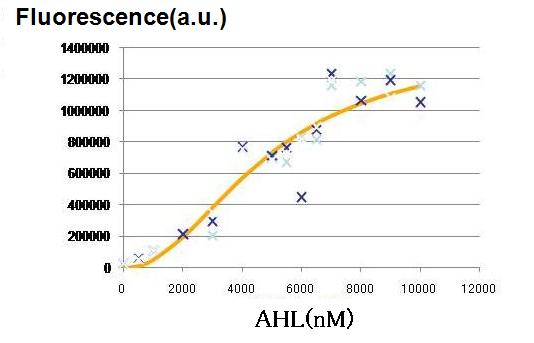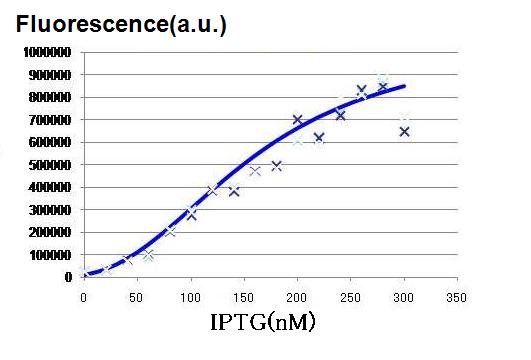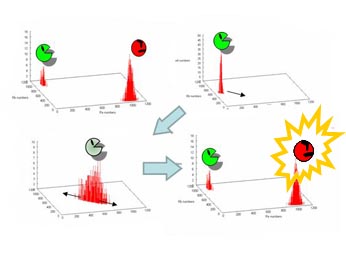Tokyo/Works
From 2007.igem.org
(→1.<span style="color:#0066ff;">Dry </span>: Formulation) |
(→First, the newly devised promoter sensed the '''Two inputs''' is necessary for the Genetic_circuit.) |
||
| Line 18: | Line 18: | ||
<!--We made hybrid promoter | <!--We made hybrid promoter | ||
前段階として、ハイブリッドプロモータの作成、及び機能確認実験を行った。ハイブリッドプロモータは2つの入力を受け取れるプロモータで我々の遺伝子回路を実装するのに必要なパーツである。今回必要な用途を満たしたものが存在しなかったので、配列から設計を行った。--> | 前段階として、ハイブリッドプロモータの作成、及び機能確認実験を行った。ハイブリッドプロモータは2つの入力を受け取れるプロモータで我々の遺伝子回路を実装するのに必要なパーツである。今回必要な用途を満たしたものが存在しなかったので、配列から設計を行った。--> | ||
| - | We | + | We created a new hybrid promoter and checked its function. ('''Fig. 1''' and '''2''') |
This newly devised hybrid promoter regulated by two inputs is essential to the genetic circuit in our project. | This newly devised hybrid promoter regulated by two inputs is essential to the genetic circuit in our project. | ||
Since there are no parts available that meet required conditions - activated by AHL and repressed by LacI - among previous publishments as well as BioBrick parts, we started with the design of its sequence. '''([[Tokyo/Works/Hybrid promoter|See more.]])''' | Since there are no parts available that meet required conditions - activated by AHL and repressed by LacI - among previous publishments as well as BioBrick parts, we started with the design of its sequence. '''([[Tokyo/Works/Hybrid promoter|See more.]])''' | ||
Revision as of 02:43, 26 October 2007
Abstract Concept & Model Requirements Genetic_circuit Works About_our_team
0. Hybrid promoter 1. Formulation 2. Assay1 3. Simulation 4. Assay2 5. Future works
以下Worksのアブストとなる文章に。上下との話のつながりも明記。
How to reach our goal
We have alternatly implemented Wet and Dry experiments to achieve our goal
Our purpose is the construction and development of genetic circuit to establish our "coexistence stability" model. We have alternately employed Dry and Wet approaches. We have drawn a navigational chart on our project by Dry approaches, which has been confirmed and reinforced by the data from Wet approaches.
0. Wet : Hybrid promoter
First, the newly devised promoter sensed the Two inputs is necessary for the Genetic_circuit.
We created a new hybrid promoter and checked its function. (Fig. 1 and 2) This newly devised hybrid promoter regulated by two inputs is essential to the genetic circuit in our project. Since there are no parts available that meet required conditions - activated by AHL and repressed by LacI - among previous publishments as well as BioBrick parts, we started with the design of its sequence. (See more.)
1.Dry : Formulation
Second, we have tried to mathmatically express our model.
From simple equations, the equations necessary for our model have been deviated step by step. In the final step a stochastic differential equation is used.(See more.)
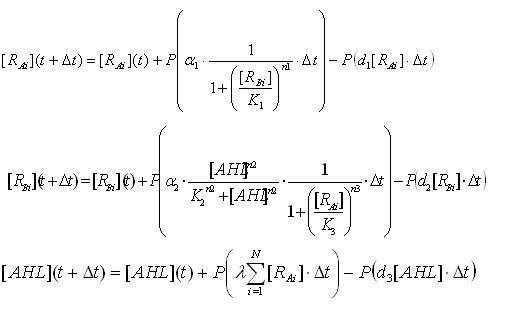
2.Wet : Assay1 using "Externally added" materials
To determine the parameters of Hill coefficients, AHL and IPTG assays were conducted.
Fig. 3 and 4 shows some results of these assays.
(See more.)
3.Dry : Simulation
Using the data from actual experiments, we simulated behaviors of our model.
Based on stochastic simulation using parameters obtained from our wet experiments, we have confirmed that the whole system becomes unstable when there are only idlers left, and then, they become either of workers and idlers. Also we have determined other parameters necessary for the desired behavior of this system. (See more.)
4.Wet : Assay2 on "Cell-produced" AHL and Expression comparison
Here the simulation results were tested by actual wet experiments.
Whether the parameters obtained in 3 is feasible in actual Wet experiments was tested by focusing on the amount of cell-produced AHL as well as the strength of the promoters. Indication from the result is applied for the next work.(See more.)
5.Future works
Through the experiments mentioned above, we have found that our model can be completed by changing some of the parts employed so far. Continuing such simulation oriented construction of genetic circuit, it will be increasingly necessary to exchange parts. Here we would like to offer useful means for part exchanges.
Based on the results from wet experiments, the next dry approach - analysis and simulation - should be performed, which will in turn be testified and confirmed by wet experiments. Continueing these processes, if time permits, would further sophisticate and complete our model. (See more.)
